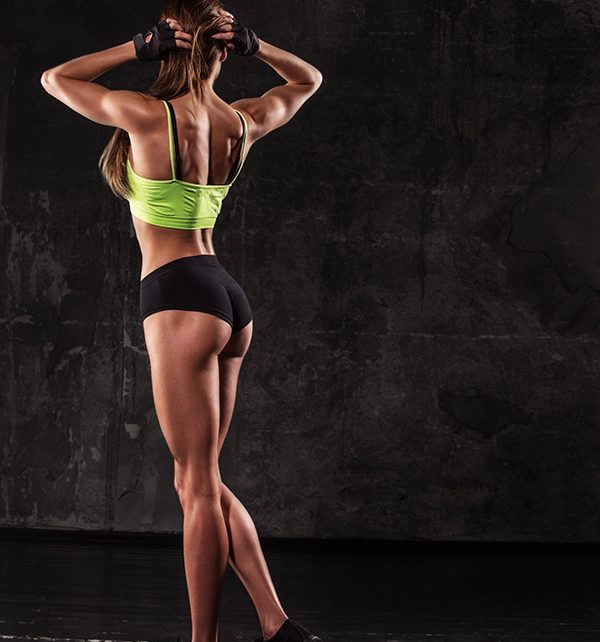The only real solution to combating cellulite is to undertake a regimented program of targeted exercise.
No area of a woman’s body attracts more attention than the hips and thighs. The allure of shapely hips accentuates a small waist, giving women the coveted hourglass physique. Training the hips and thighs also confers many anti-aging benefits. Let’s take a look at some of the ways a targeted workout can turn back the clock on your body.
Bone Building
The loss of bone is a huge, age-related concern for women. Like all living tissues, bone cells are constantly dying off. The body deals with this event through a process called “remodeling.” Simply stated, remodeling is the ongoing procedure of breaking down and building up of bone tissue in order to maintain optimal function. The entire remodeling cycle takes about four months to complete, and continues throughout the course of your life.
Remodeling begins with bone resorption, where old bone tissue is broken down. Think of resorption as a demolition team that excavates unneeded materials so renovation can take place. Once resorption is complete, bone reformation commences. Here, protein-secreting cells called osteoblasts are activated, which patch up the holes left from resorption and rebuild bone tissue. Under ideal circumstances, the new bone is as strong – or stronger – than the old.
During adolescence, bone formation tends to be greater than breakdown. Increases in bone mineral density continue throughout the third decade of life, and generally peak at around 30 years of age. After 30, though, things begin to turn around. Osteoblasts become less efficient at making new bone tissue and consequently, bone is stripped away faster than it’s replaced. This brings about a condition called osteopenia (bone loss), which, unless counteracted by proper exercise and nutrition, only gets worse as time goes by. Ultimately, this can lead to osteoporosis, a debilitating condition that affects over 20 million people annually – 80 percent of them women.
One of the most common sites of osteoporosis is the hip – a condition that often leads to hip fracture. Thousands are hospitalized each year due to this malady and roughly half, most of them elderly, never recover from the incident. Many end up incapacitated, having no choice but to spend the rest of their years in a skilled nursing facility.
Fortunately, exercise can help offset the age-related decline in bone mineral density. Exercise not only helps to maintain existing bone mass, but actually can improve the strength of your bones. Realize, though, that to achieve desired benefits, the exercise has to be weight bearing. What’s more, results are regionally specific to the areas trained. Thus, only by performing targeted training of the hips and thighs will you prevent the age-related loss of bone, and reduce the possibility of fracture.
Cellulite Busting
One of a woman’s biggest age-related concerns is the appearance of cellulite. It’s estimated that up to 90 percent of all women develop some cellulite after 30, and the condition tends to worsen over time. Although cellulite can form anywhere on the body, it’s most apt to appear on the back of the thighs.
Contrary to popular belief, cellulite is actually related to the composition of the skin. The skin and its underlying tissue have three fundamental layers: the top layer is comprised of a cellular-based tissue called the dermis. Its primary purpose is to protect your body from outside contaminants. The middle layer is made up of fibrous connective tissue called superficial fascia. It’s substantially thicker than the dermis and acts like an internal stocking to support the skin, holding body fat in place. The lower layer is made up of adipose tissue – plain old fat. It has several functions, including insulating the body, padding the internal organs and providing a source of long-term energy.
Given its role in supporting the skin, it’s the superficial fascia that’s responsible for the appearance of cellulite. In men, the superficial fascia is arranged in a crisscross pattern that’s strong and consistent. Accordingly, fat is contained in a uniform manner subcutaneously (below the skin), leaving the skin surface relatively smooth and supple. In women, however, the superficial fascia tends to be irregular and discontinuous. It has a vertical distribution, forming honeycomb-like patterns beneath the dermis. Hence, when fat accumulates, it pushes up toward the skin’s surface in clusters, giving the skin the lumpy, dimpled appearance commonly known as cellulite.
As you age, skin begins to sag and loses its elasticity, and the superficial fascia becomes more and more irregular, thereby losing its ability to contain subcutaneous tissue. With a diminished support network, cellulite becomes ever more prominent, creating what has come to be known as the “orange peel” look.
The only real solution to combating cellulite is to undertake a regimented program of targeted exercise. While it isn’t a “cure all” (there simply is no way to reconfigure the underlying connective tissue), a well-designed thigh-training program can help to substantially reduce, if not completely eliminate, any sign of cottage cheese thighs. Lean muscle tone helps smooth underlying fat, making cellulite less evident. In addition, once body fat is reduced to acceptable levels, your thighs will be taut and toned, with minimal dimpling.
Fat Fighting
There’s no greater aging concern than obesity. Statistics show that the typical woman has approximately 20 percent body fat at the age of 20, 30 percent at the age of 30, and 40 percent at the age of 40. By the time a woman reaches her 50th birthday, roughly half her body is comprised of fat.
The age-related accretion of body fat is largely due to a loss of muscle tissue, as women lose up to 1 percent of their muscle mass each year after the age of 30, and continue to do so throughout the rest of their lives. Muscle is the most metabolically active tissue in the body; the more you have, the more calories you burn. Thus, a reduction of muscle progressively slows metabolism, causing a gradual, but steady, increase in body fat.
It should come as no surprise, therefore, that resistance training is the most important activity in staying lean. It’s estimated that for each pound of muscle you add to your body, you burn approximately 40 to 50 additional calories a day at rest. That means you’re burning these calories around the clock – even while you’re relaxing on the couch, reading a book or streaming a movie!
Since the hips and thighs comprise more than a third of your overall lean body mass, it should be apparent how important it is to train them diligently. Targeted training will produce shapely muscle that’s metabolically active, helping to keep your body fat to a minimum.
The Routine
The following routine is a periodized program designed to accentuate leaner, shapelier hips and thighs. You will alternate between performing a strength/shaping workout and an endurance/toning workout. Because of the intense nature of the program, you should perform it no more than twice a week, taking a minimum of three to four days between workouts. Thus, you could adhere to a schedule where you trained your hips and thighs on Monday/Thursday, Tuesday/Friday, Wednesday/Saturday, etc.
The following are the program’s protocols. If you stay dedicated and perform the routine as directed, you should see results within a month’s time.
Sets: For the strength/shaping workout, you’ll perform three sets of each exercise. The sets will be executed in a “straight” fashion, meaning you’ll do a set, rest for the prescribed amount of time, do another set, rest, and then perform one last set. You’ll finish all sets for a particular exercise before moving onto the next exercise.
Thus, you’ll begin by performing a set of walking lunges. After executing the specified number of repetitions, you’ll take a brief rest, perform another set of walking lunges, rest again, and then perform a final set of walking lunges. You’ll then move to your next exercise and proceed in a similar manner throughout the course of the workout.
For the endurance/toning workout, you’ll perform three sets of each exercise. The sets will be executed as giant sets. A giant set is any set that incorporates three or more different exercises in succession. You move directly from one exercise to the next, without resting between movements. This not only heightens exercise intensity (and thus, muscle development), but also creates an aerobic environment, thereby expediting fat burning.
You’ll perform two separate giant sets. The first giant set will be comprised of the walking lunge, sissy squat and leg extension. Thus, you’ll begin by performing a walking lunge then, upon completing the specified number of reps, go immediately to the sissy squat for the specified number of reps and then immediately proceed to the leg extension. After a brief rest, you’ll repeat the process, rest again and repeat the process a final time. Then you’ll move to a giant set for the lying curl, standing cable abduction and machine abduction, performed in the same fashion as described.
Repetitions:
For the strength/shaping workout, you’ll employ a moderate-repetition scheme, aiming for 8 to 10 reps per set. This will maximize muscle fiber recruitment and stimulation, resulting in optimal development of your target region.
For the endurance/toning workout, you’ll utilize a high-repetition scheme, aiming for 15 to 20 reps per set. This targets the slow-twitch muscle fibers, which, despite their lack of growth potential, make a significant contribution to the quality of your muscle and help to produce a sleek, hard physique.
Regardless of the rep range, the weight you choose must be heavy enough so that the last few reps of the set are difficult, if not impossible, to complete. If you’re not struggling on the last few reps, the weight is too light. Alternatively, if you aren’t able to execute the minimum number of reps, the weight is too heavy. With a little experimentation, you’ll soon have a handle on exactly how much weight you should use for each exercise. Remember, intensity is the most important determinant in body sculpting; make sure you don’t take the easy way out!
Rest Intervals:
For the strength/shaping workout, you’ll take between 60 to 90 seconds between sets. Given the moderate repetition range (and corresponding heavier weight load), your muscles will need a little longer to recuperate than with a higher rep/lighter load scheme. Sixty to 90 seconds has been shown to maximize the anabolic stimulus in your body, while providing sufficient time to allow you to come back strong on successive sets.
For the endurance/toning workout, you’ll keep your rest intervals to a minimum, taking no more than 30 seconds between giant sets (there should be little or no rest between exercises during a giant set). As a rule, training should commence before you can fully catch your breath. This will create a distinct aerobic effect, keeping your heart rate elevated throughout the session. This results in a substantial increase in caloric expenditure, ultimately helping to elevate metabolism and reduce body fat.
The Exercises
Walking Lunge: Stand in an open area with your feet shoulder-width apart. Take a long stride forward with your right leg, bringing your left knee to just above floor level. Keep your shoulders back and your head up through the move. Step forward with your left leg, bringing your right knee toward the ground. Make sure your knee doesn’t go past the plane of your big toe. Alternate legs for the desired repetitions.
Sissy Squat: Begin by taking a shoulder-width stance. Grasp onto a stationary object with one hand and rise up, onto your toes. In one motion, slowly slant your torso back, bend your knees and lower your body downward. Thrust your knees forward as you descend and lean back until your torso is almost parallel with the floor. Then, reverse direction, and rise upward until you reach the starting position.
Leg Extension: Begin by sitting back in a leg extension machine. Bend your knees and place your instep underneath the roller pad located at the bottom of the machine. Grasp the machine’s handles for support. Slowly bring your feet upward until your legs are just short of parallel with the ground. Contract your quads and then reverse direction, returning back to the start position.
Lying Leg Curl: Begin by lying facedown on a lying leg curl machine, with your heels hooked underneath the roller pads. Keep your thighs pressed to the machine’s surface. Slowly curl your feet upward, stopping just short of touching your butt or as far as comfortably possible. Contract your hamstrings and then reverse direction, returning back to the start position. To increase stress to the hamstrings, choose a machine that provides a bend at the hips.
Standing Cable Abduction: Begin by attaching a cuff to a low cable pulley and then securing the cuff to your right ankle. Position yourself so your left side faces the weight stack, and grasp onto a sturdy portion of the machine for support. Pull your right leg across your body and directly out to the side.
Contract your hip muscles and then slowly return the weight along the same path, back to the start position. After finishing the desired number of repetitions, invert the process and repeat on the left.
Machine Abduction: Begin by sitting in an abductor machine and, with your legs together, place your outer thighs on the restraint pads. Slowly force your legs apart as far as comfortably possible. Contract your hip muscles and then reverse direction, returning back to the start position.
The post Blast Cellulite: Sculpt Your Hips and Thighs first appeared on FitnessRX for Women.





